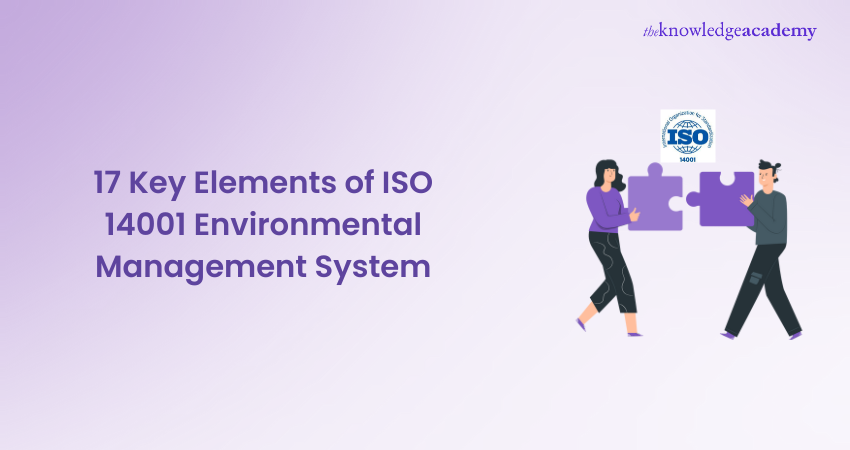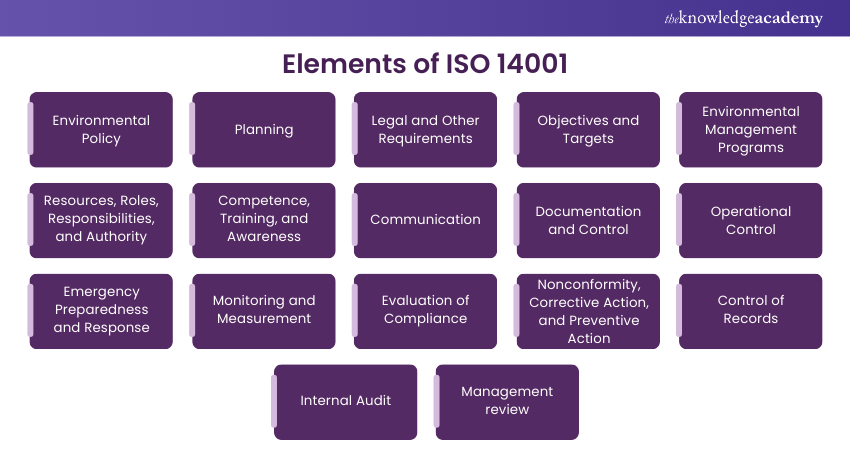We may not have the course you’re looking for. If you enquire or give us a call on +08000201623 and speak to our training experts, we may still be able to help with your training requirements.
We ensure quality, budget-alignment, and timely delivery by our expert instructors.

When it comes to effectively managing environmental responsibilities, organisations worldwide turn to ISO 14001. However, before implementing the standard for Environmental Management Systems (EMS), it is crucial to understand the Elements of ISO 14001. These elements form a framework that helps organisations manage their environmental responsibilities effectively including the identification and consideration of ISO 14001 Risks and Opportunities for a comprehensive approach.
According to the 2022ISO Survey of Management Systems, there are over 400,000 ISO 14001 certificates spanning over 600,000 sites. Furthermore, companies can demonstrate their commitment to environmental sustainability and improve their environmental performance by implementing the ISO 14001 standard. If you are a business leader striving to enhance the effectiveness of your organisation’s EMS, the 17 Elements of ISO 14001 discussed in this blog will guide you towards excellence.
Table of Contents
1) Overview of the ISO 14001
2) 17 Elements of the ISO 14001
a) Environmental Policy
b) Planning
c) Legal and Other Requirements
d) Objectives and Targets
e) Environmental Management Programs
f) Resources, Roles, Responsibilities, and Authority
3) Conclusion
Overview of the ISO 14001
Whereas, ISO 14001 Software is designed to support organisations in implementing the ISO 14001 Environmental Management Systems (EMS) standard. This software streamlines the process of managing environmental responsibilities, helping organisations to establish and monitor policies, objectives, and targets more efficiently. By leveraging ISO 14001 Software, companies can better adhere to the structured framework of ISO 14001, thereby enhancing their overall environmental performance. However, organisations should also consider the potential Disadvantages of ISO 14001, such as the initial costs of implementation, the time required for certification, and the need for continuous monitoring and updates to maintain compliance.
Nonetheless, The ISO 14001 Life Cycle is integral to the implementation of the ISO 14001 Environmental Management Systems (EMS) standard, providing a structured approach for continuous improvement in environmental performance. ISO 14001 Software enhances the management of this life cycle by streamlining processes such as policy establishment, objective setting, and performance monitoring. Together, the ISO 14001 standard, its life cycle, and the supporting software enable organisations to efficiently manage their environmental responsibilities and achieve their sustainability goals.

17 Elements of the ISO 14001
ISO 14001 consists of 17 key elements that form the foundation of an effective Environmental Management System. These elements ensure that organisations effectively manage their environmental responsibilities, drive continuous improvement, and demonstrate their commitment to sustainable practices. These elements described below:

1) Environmental Policy: The environmental policy sets the overall direction and commitment of the organization towards environmental sustainability. It outlines the organization's objectives and targets for environmental performance, highlighting its alignment with relevant standards like the Difference Between ISO 14001 and ISO 45001 in ensuring compliance and risk management.
2) Planning: This element involves identifying environmental aspects, assessing impacts, and defining objectives and targets to address significant environmental issues. It includes establishing action plans and allocating resources accordingly.
3) Legal and Other Requirements: Organisations must identify and comply with applicable environmental laws, regulations, and other requirements relevant to their activities, products, and services.
4) Objectives and Targets: Establishing measurable objectives and targets aligned with the organisation's environmental policy helps drive continuous improvement in environmental performance.
Ensure your organisation’s environmental compliance with our ISO 14001- Sign up now!
5) Environmental Management Programs: Organisations develop and implement programs to achieve their environmental objectives and targets effectively. These programs include defining responsibilities, timelines, and performance indicators.
6) Resources, Roles, Responsibilities, and Authority: Clearly defining roles, responsibilities, and authorities related to Environmental Management ensures effective implementation of the EMS. Adequate resources, both human and financial, must be allocated for its successful operation.
7) Competence, Training, and Awareness: Organisations need to ensure that personnel working within the EMS have the necessary knowledge, skills, and awareness of environmental issues to perform their tasks effectively.
8) Communication: Establishing effective internal and external communication channels facilitates the exchange of environmental information, including environmental policies, objectives, and performance results.
9) Documentation and Control: Organisations must maintain documented information to ensure the effective operation of the EMS. This includes procedures, work instructions, and records related to Environmental Management. Effective Document Control ISO 14001 is essential to manage and organise these documents properly.
10) Operational Control: Implementing controls and procedures to manage operations that can significantly impact the environment is crucial. This element ensures compliance with environmental requirements during routine activities.
11) Emergency Preparedness and Response: Organisations must identify potential environmental emergencies, develop response procedures, and conduct drills to ensure prompt and effective action during crises.
12) Monitoring and Measurement: Regular monitoring and measurement of key environmental indicators provide data for evaluating the performance of the EMS, identifying trends, and implementing corrective actions.
13) Evaluation of Compliance: Organisations need to assess their compliance with applicable environmental laws and emphasising the importance of ISO 14001 Compliance for effective environmental management regulations to identify gaps and take appropriate corrective measures.
14) Nonconformity, Corrective Action, and Preventive Action: When deviations from planned procedures or nonconformities occur, organisations must investigate the root causes, take corrective actions, and implement measures to prevent recurrence.
15) Control of Records: Establishing a robust record-keeping system ensures the availability and integrity of Environmental Management-related records for future reference and audits.
16) Internal audit: Regular ISO 14001 Audits evaluate the EMS's effectiveness, identify improvement areas, and verify compliance with ISO 14001 requirements.
17) Management review: Top management conducts periodic reviews to ensure the EMS's continued suitability, adequacy, and effectiveness. This review includes assessing opportunities for improvement and making necessary changes.
Enhanced market competitiveness is achieved through environmental responsibility, in line with updated ISO 14001:2015>ISO 14001:2015 standards emphasising sustainable practices."
ISO 14001 software can be instrumental in implementing and managing these 17 key elements efficiently.
Apply ISO principles within your organisation by signing up for the ISO 14001 Foundation Course now!
Conclusion
The essential 17 Elements of ISO 14001, outlined in this blog, provide a comprehensive framework for building a successful Environmental Management System (EMS). Implementing ISO 14001 helps organizations adopt a systematic approach to Environmental Management. With this framework, companies can enhance their environmental performance, comply with legal requirements, and demonstrate their commitment to sustainability to stakeholders and customers. For professionals looking to excel in this field, preparing for Environmental Health and Safety Interview Questions can be a crucial step in showcasing their expertise.
Deepen your understanding of regulatory compliance for sustainable practices with our ISO 14001 Lead Auditor Course - Sign up now!
Frequently Asked Questions
How Can Organisations Achieve Certification to ISO 14001?

The steps to achieving ISO 14001 Certification typically involve:
a) Conducting initial gap analysis to identify improvement areas.
b) Developing a responsible team.
c) Implementing an EMS that meets ISO 14001 requirements.
d) Conducting internal audit to ensure EMS functionality.
e) Undertaking certification audit for compliance verification.
What are the Challenges Associated with ISO 14001?

Some of the challenges associated with ISO 14001 are:
a) Overcoming lack of motivation, qualified personnel, lack of financial capability in environmental targets
b) Shifting from compliance to continual improvement
c) Dealing with non-conformances as opportunities to do better
d) Applying relevant legislation to all parts of the business
What are the Other Resources and Offers Provided by The Knowledge Academy?

The Knowledge Academy takes global learning to new heights, offering over 3,000 online courses across 490+ locations in 190+ countries. This expansive reach ensures accessibility and convenience for learners worldwide.
Alongside our diverse Online Course Catalogue, encompassing 19 major categories, we go the extra mile by providing a plethora of free educational Online Resources like News updates, Blogs, videos, webinars, and interview questions. Tailoring learning experiences further, professionals can maximise value with customisable Course Bundles of TKA.
What is The Knowledge Pass, and How Does it Work?

The Knowledge Academy’s Knowledge Pass, a prepaid voucher, adds another layer of flexibility, allowing course bookings over a 12-month period. Join us on a journey where education knows no bounds.
What are the Related Courses and Blogs Provided by The Knowledge Academy?

The Knowledge Academy offers various ISO 14001 Certification Courses, including the ISO 14001 Foundation Course and the ISO 14001 Lead Auditor Course. These courses cater to different skill levels, providing comprehensive insights into Environmental Management System (EMS).
Our Health & Safety Blogs cover a range of topics related to Environmental Compliance, offering valuable resources, best practices, and industry insights. Whether you are a beginner or looking to advance your ISO 14001 skills, The Knowledge Academy's diverse courses and informative blogs have got you covered.
Upcoming Health & Safety Resources Batches & Dates
Date
 ISO 14001 Foundation Certification
ISO 14001 Foundation Certification
Mon 21st Apr 2025
Mon 23rd Jun 2025
Mon 18th Aug 2025
Mon 20th Oct 2025
Mon 15th Dec 2025






 Top Rated Course
Top Rated Course


 If you wish to make any changes to your course, please
If you wish to make any changes to your course, please


